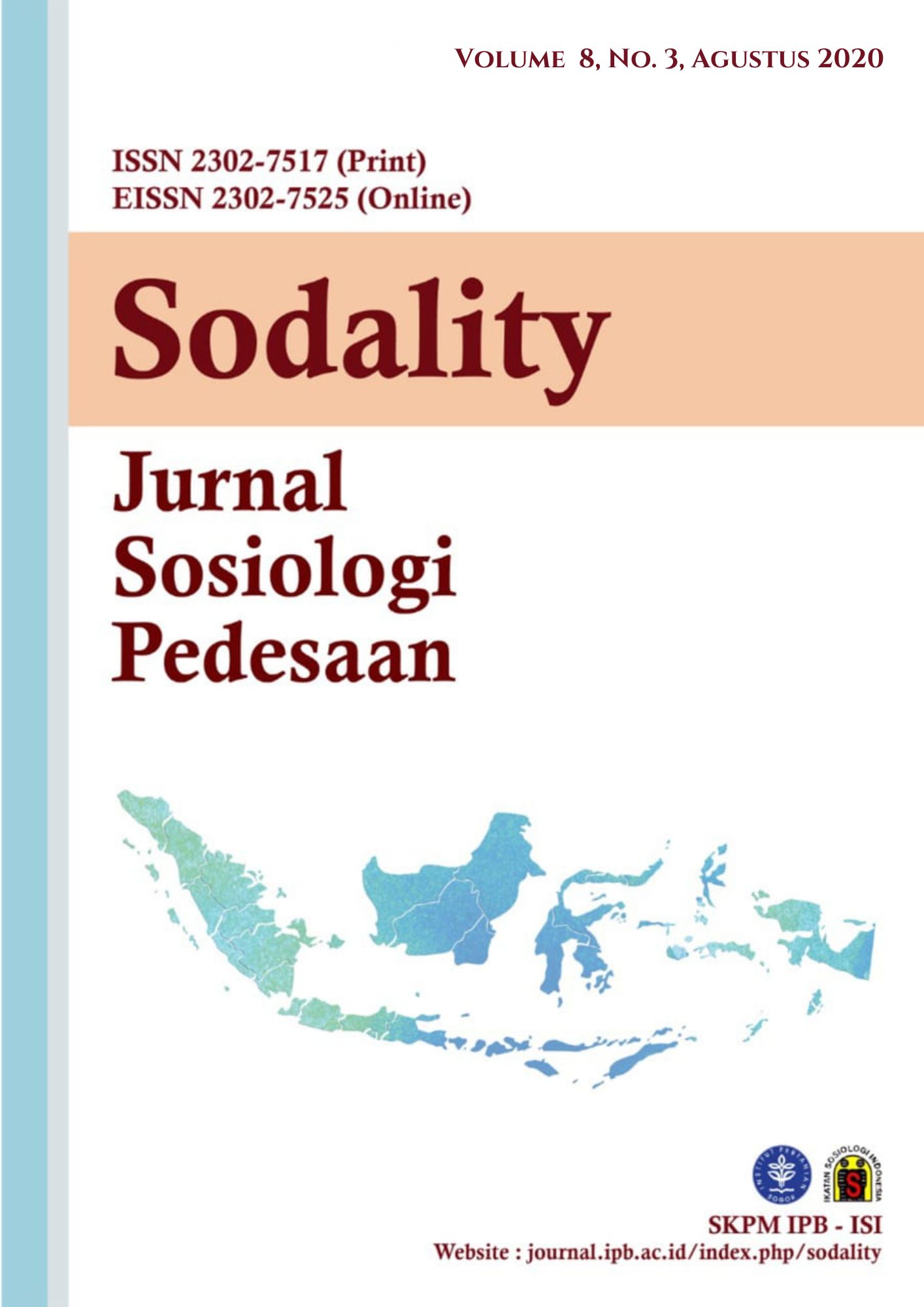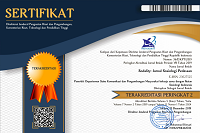Empowering Women Ex-Migrant Workers and Domestic Violence Victims through Komunitas Perempuan Singkong Jaya
Abstract
This article seeks to understand the empowerment of women ex-migrant workers who have faced various problems before, during and after going back to the homeland as ex-migrant workers. These problems include unemployment, family’s affairs, exploitation, discrimination and domestic violence. Komunitas Perempuan Singkong Jaya has been established to carry out empowerment programs to overcome these problems. The purpose of this study is to identify the needs as well as the problems that hinder the implementation of the programs and seeks to find the solutions. This study employs descriptive qualitative approach to examine the implementation of the development programs which have been conducted by Komunitas Perempuan Singkong Jaya located in Desa Sukowilangun, Kec. Kalipare, Kab. Malang. Based on the findings, there are several problems in the implementation of development programs, including the lack of capital and facilities, packaging and marketing, as well as product license problems. Addressing these problems, some intervention programs have been conducted, including training and funding which have generated intended outputs. However, this study also found that the change in lifestyle of these women ex-migrant workers has resulted in their being reluctant to be involved in the development programs.
References
Abas, S., Widyahseno, B., & Rudianto. (2016). Model Pemberdayaan TKI Pasca Migrasi melalui Ekonomi Produktif Menuju Keluarga Sakinah. Muaddib: Studi Kependidikan dan Keislaman, 4(1), 1–19. https://doi.org/10.24269/MUADDIB.V4I1.92
Abdi, I. R. (2008). Intervensi Komunitas: Pengembangan Masyarakat sebagai Upaya Pemberdayaan Masyarakat. Jakarta: Rajagrafindo Persada.
Adi, I. R. (1994). Psikologi, Pekerjaan Sosial dan Ilmu Kesejahteraan Sosial: Dasar-dasar Pemikiran. Jakarta: Rajawali Pers.
Adi, I. R. (2008). Intervensi Komunitas: Pengembangan Masyarakat sebagai Upaya Pemberdayaan Masyarakat. Jakarta: Rajawali Pers.
Assumptah, H., & Suharko. (2016). Praktek Pemberdayaan Tenaga Kerja Indonesia Purna di BP3TKI (Balai Pelayanan Penempatan Perlindungan Tenaga Kerja Indonesia). Yogyakarta: Universitas Gadjah Mada.
Backhans, M. C., Lundberg, M., & Månsdotter, A. (2007). Does increased gender equality lead to a convergence of health outcomes for men and women? A study of Swedish municipalities. Social Science and Medicine, 64(9), 1892–1903. https://doi.org/10.1016/j.socscimed.2007.01.016.
Batliwala, S. (1993). Empowerment of Women in South Asia. New Delhi: FAO.
Berner, E., & Phillips, B. (2005). Left to their own devices? Community self-help between alternative development and neo-liberalism. Community Development Journal, 40(1), 17–29. https://doi.org/10.1093/cdj/bsi003
Bhattacharyya, J. (2004). Theorizing Community Development. Journal of the Community Development Society, 34(2), 5-34. https://doi.org/10.1080/15575330409490110.
Bungin, B. (2010). Penelitian Kualitatif: Komunikasi, Ekonomi, Kebijakan Pulbik dan Ilmu Sosial Lainnya. Jakarta: Kencana Predana Media Group.
Chambers, R. (1995). Poverty and livelihoods: whose reality counts?. ID discussion paper. Brighton: IDS.
Chawa, A. F., Al Yusainy, C., Adila, I., & Kusumastuti, A. (2018). Deemphasize Community Development Programs on Migran Workers. Jurnal Terapan Abdimas, 3(2), 170. https://doi.org/10.25273/jta.v3i2.2807.
Dewi, N. (2019). Gaji Pekerja Migran Rp 7,6 Miliar Dikemplang, KJRI Jeddah Bicara. Tempo.Co. Retrieved from https://nasional.tempo.co/read/1232576/gaji-pekerja-migran-rp-76-miliar-dikemplang-kjri-jeddah-bicara.
Febrinastri, F., & Hapsari, D. K. (2019). Sejak 2014, BNP2TKI Tempatkan 1,5 Juta Pekerja Migran Indonesia. Suara.Com. Retrieved from https://www.suara.com/news/2019/07/09/075749/sejak-2014-bnp2tki-tempatkan-15-juta-pekerja-migran-indonesia.
Haggis, J., Jarrett, S., Taylor, D., & Mayer, P. (1986). By the teeth: A critical examination of James Scott’s The moral economy of the peasant. World Development, 14(12), 1435–1455. https://doi.org/10.1016/0305-750X(86)90042-2.
Hasin, F., & Musa, H. H. (2018). Women Empowerment Model : Strategies To Overcome Challenges Research Article Special Issue. Journal of Fundamental and Applied Science, 10(July 2019), 1068–6083. https://doi.org/10.4314/jfas.v10i1s.78.
Ife, J. (2013). Community Development in an Uncertain World: Vision, Analysis and Practice. Melbourne: Cambridge University Press.
Kabeer, N. (2003). Reserved Realities: Gender Hierarchies in Development. London: Verso.
Kenny, S. (2006). Developing Communities: For the Future. Melbourne: Thomson.
Korten, D., & Carner, G. (1984). Planning Framework for People-Centered Development;Contributions Toward Theory and Planning Frameworks. Kumarian Press.
Koser, K., & Laczko, F. (2010). World Migration Report. https://doi.org/10.18356/f0a20a86-en.
Lambert, V. a., & Lambert, C. E. (2013). Qualitative Descriptive Research: An Acceptable Design. Pacific Rim International Journal of Nursing Research, 16(4), 255–256. Retrieved from http://antispam.kmutt.ac.th/index.php/PRIJNR/article/download/5805/5064.
Larrison, C. (2002). A Comparison of Top-Down and Bottom-up Community Development Intervention in Rural Mexico: Practical and Theoritical Implications for Community Development Programs. New York: Edwin Mellen Press.
Manuere, F., & Phiri, N. (2018). A Literature Review of Women Empowerment and Development in Zimbabwe: A look at New Insights and Perspectives. Journal of Public Administration and Governance, 8(4), 57. https://doi.org/10.5296/jpag.v8i4.13818.
Marfo, E. (2008). Institutionalizing citizen participation and community representation in natural resource management: Lessons from the social responsibility agreement negotiation in Ghana. Community Development Journal, 43(4), 398–412. https://doi.org/10.1093/cdj/bsm028.
May, T. (2011). Social Research: Issues, Methods and Process (Fourt). Berkshire: McGrawHill Open University Press.
Morrison, A. R., & Biehl, M. L. (2007). Too Close to Home: Domestic Violence in Latin America. Washington, DC: Inter-American Development Bank.
Munawaroh, K. (2019). Community E Mpowerment Model Through Optimization of The Role of Indonesian Migrant Workers (PMI ) Purna In Encouraging A Chievement Of The Sustainable Development Goal In East. Jurnal Ilmiah Administrasi Publik Dan Pembangunan, 10(1), 19–26.
Nursalam, Yusuf, A., Widyawati, I. Y., & Asmoro, C. P. (2015). Peningkatan Kemandirian Perawat Tenaga Kerja Indonesia (TKI) Yang Terinfeksi HIV Melalui Pengembangan Model Pemberdayaan Keluarga dan Peer Group Support. Jurnal Ners, 10(2), 265–271.
Octaviani, L. (2015). Pemanfataan Remitansi Ekonomi dan Sosial di Kalangan Buruh Migran Perempuan. Forum Ilmu Sosial, 42(1), 57–69.
Onyx, J., & Benton, P. (1995). Empowerment and Ageing: Toward Honoured Places for Crones and Sages (Community; G. Craig & M. Mayo, Eds.). New Jersey: Zed Books.
Raharto, A., & Noveria, M. (2012). Advocacy Groups for Indonesian Women Migrant Workers Protection. Jurnal Kependudukan Indonesia, 7(1), 1–18. https://doi.org/10.14203/JKI.V7I1.80
Rahman, A. (2013). Women’s Empowerment: Concept and Beyond. Global Journal Og Human Social Science. Sociology & Culture, 13(6), 9–14. Retrieved from https://globaljournals.org/GJHSS_Volume13/2-Womens-Empowerment-Concept.pdf
Rowlands, J. (1997). Questioning Empowerment: Working With Women in Honduras. 196. Retrieved from http://books.google.co.uk/books?id=fXJKq2JQtyoC
Sandelowski, M. (2000). Focus on research methods: Whatever happened to qualitative description? Research in Nursing and Health, 23(4), 334–340. https://doi.org/10.1002/1098-240x(200008)23:4<334::aid-nur9>3.0.co;2-g
Schulz, A. J., Israel, B. A., Zimmerman, M. A., & Checkoway, B. (1995). Perceived Control at the Individual, Organizational and Community Levels The Program on Conflict Management Alternatives a t The University of Michigan. Health Education Research : Theory and Practice, 10(3), 309–327. Retrieved from https://deepblue.lib.umich.edu/bitstream/handle/2027.42/51261/495.pdf?sequence=1&isAllowed=y
Scott, J. C. (1976). The Moral Economy of the Peasant: Rebellion and Subsistence in Southeast Asia. USA: Yale University.
Siegel, M., & Waidler, J. (2012). UNU ‐ MERIT Working Paper Series Migration and multi ‐ dimensional poverty in Moldovan communities. Netherland.
Sitepu, A. (2011). Tindak Kekerasan Terhadap Perempuan Pekerja Migran. Informasi, Vol 16 No.(01), 15.
Sulaiman, A. I., Sugito, T., & Sabiq, A. (2017). Komunikasi Pembangunan Partisipatif untuk Pemberdayaan Buruh Migran. Jurnal Ilmu Komunikasi, 13(2), 233. https://doi.org/10.24002/jik.v13i2.734.
Supriana, T., & Nasution, L. (2010). The Role of Ex-Migrant Worker Enterprise Toward Local Economic Development and Factors that Influence Income of Ex-Migrant Enterprise in Sumatera Utara Province. Makara Human Behavior Studies in Asia, 14(1), 42. https://doi.org/10.7454/mssh.v14i1.571.
Sushama, S. (1998). Women and Empowerment: Approach and Strategies. Delhi: Publishing House.
Tiwari, R. S. (2001). Feminism and Globalization versus Indian Women Empowerment. New Delhi: Rawat Publication.
van den Berg, M. (2010). Household income strategies and natural disasters: Dynamic livelihoods in rural Nicaragua. Ecological Economics, 69(3), 592–602. https://doi.org/10.1016/j.ecolecon.2009.09.006
Wijayanigtyas, D. A. (2016). Pemberdayaan Tenaga Kerja Indonesia (TKI) Purna dan Keluarganya Melalui Pembentukan Sentra Usaha (Studi tentang Implementasi Pemberdayan Kelompok TKI Purna Tunas Jaya Desa Nglanggeran, Kec. Patuk, Kab. Gunungkidul, Daerah Istimewa Yogyakarta. Universitas Gadjah Mada.
Authors who publish with this journal agree to the following terms:
- Authors retain copyright and grant the journal right of first publication with the work simultaneously licensed under a

This work is licensed under a Creative Commons Attribution 4.0 International License. that allows others to share the work with an acknowledgement of the work's authorship and initial publication in this journal. - Authors are able to enter into separate, additional contractual arrangements for the non-exclusive distribution of the journal's published version of the work (e.g., post it to an institutional repository or publish it in a book), with an acknowledgement of its initial publication in this journal.
- Authors are permitted and encouraged to post their work online (e.g., in institutional repositories or on their website) prior to and during the submission process, as it can lead to productive exchanges, as well as earlier and greater citation of published work (See The Effect of Open Access).





.png)









